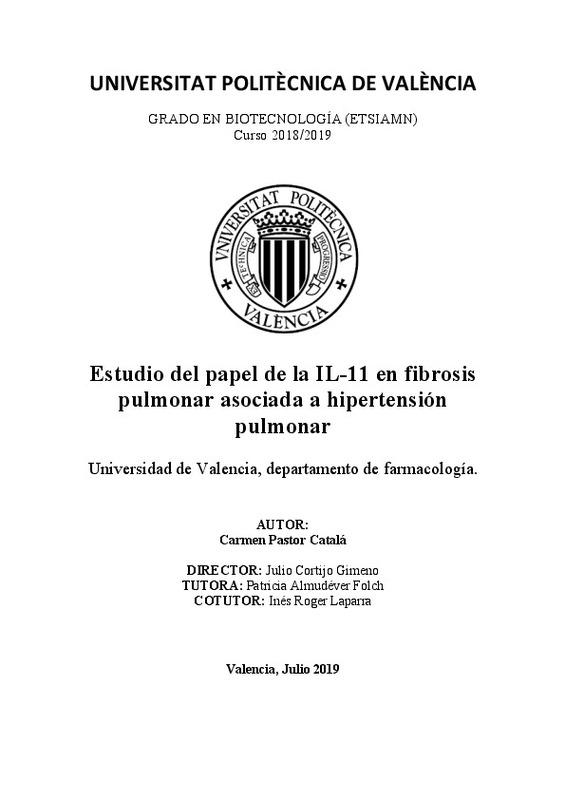|
[ES] La fibrosis pulmonar idiopática (FPI) es una enfermedad intersticial de curso crónico y
progresivo que se caracteriza por la activación de fibroblastos invasivos que se depositan y
remodelan la matriz extracelular ...[+]
[ES] La fibrosis pulmonar idiopática (FPI) es una enfermedad intersticial de curso crónico y
progresivo que se caracteriza por la activación de fibroblastos invasivos que se depositan y
remodelan la matriz extracelular (ME) destruyendo el tejido. Una proporción de pacientes con
FPI desarrolla hipertensión pulmonar (HP). La HP es una enfermedad que se caracteriza por
presentar vasoconstricción y remodelado de las arterias pulmonares, aumentando la resistencia
vascular pulmonar y la presión arterial. El desarrollo de ésta empeora sustancialmente la
evolución de pacientes con FPI. A pesar de las numerosas investigaciones en la patogénesis de
la FPI, las terapias disponibles son muy escasas. Actualmente los únicos fármacos antifibróticos
aprobados para el tratamiento de la FPI son Nintedanib y Pirfenidona, sin embargo tienen
toxicidades elevadas y no mejoran la supervivencia de los pacientes con dicha patología. Por
ello es necesario la investigación de nuevas dianas terapéuticas con el fin de mejorar la
supervivencia de los pacientes.
El objetivo general de dicho trabajo es el estudio del papel de IL-11 en pacientes con
FPI asociada a HP. Para ello, se estudió la expresión y la distribución de IL-11 y su receptor,
IL-11Rα, en pacientes con FPI con o sin HP. Por otro lado, se hipotizó si la estimulación de
células musculares de arteria pulmonar (PASMCs) y células microvasculares endoteliales de
arteria pulmonar (HMVECs) con IL-11 inducía un fenotipo fibrótico con la transformación de
dichas células a miofibroblastos invasivos.
[-]
[EN] Idiopathic pulmonary fibrosis (IPF) is a chronic and progressive interstitial disease
characterized by the activation of invasive fibroblasts that deposit and remodel the extracellular
matrix (ME) by destroying the ...[+]
[EN] Idiopathic pulmonary fibrosis (IPF) is a chronic and progressive interstitial disease
characterized by the activation of invasive fibroblasts that deposit and remodel the extracellular
matrix (ME) by destroying the tissue. A proportion of patients with IPF develop pulmonary
hypertension (PH).
The PH is a disease characterized by vasoconstriction and remodeling of pulmonary
arteries, increasing pulmonary vascular resistance and blood pressure. The development of this
worsens substantially the outcome of patients with IPF. Despite numerous investigations in the
pathogenesis of IPF the available therapies are limited. Currently the only antifibrotic drugs
approved for the treatment of FPI are Nintedanib and Pirfenidona, however they have high
toxicities and do not improve the survival of patients with such pathology. Research on new
therapeutic targets is therefore necessary in order to improve patient survival.
The overall aim of this project is the study of the role of IL-11 in patients with IPF associated
with HP. For this purpose, the expression and distribution of IL-11 and its receptor, IL-11Rα,
were studied in patients with IPF with or without HP. On the other hand, it was hypothesized
whether the stimulation of pulmonary artery muscle cells (PASMCs) and endothelial
pulmonary artery microvascular cells (HMVECs) with IL-11 induced a fibrotic phenotype by
transforming these cells to invasive myofibroblasts.
[-]
|







